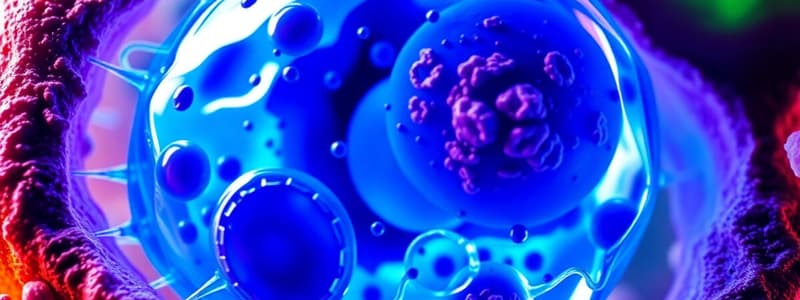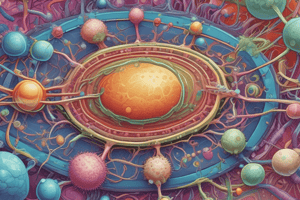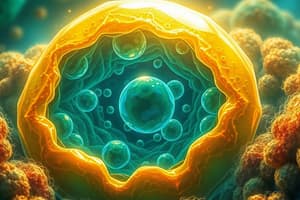Podcast
Questions and Answers
Which of the following structures is unique to eukaryotic cells?
Which of the following structures is unique to eukaryotic cells?
- Plasma membrane
- Circular DNA
- Ribosomes
- Mitochondria (correct)
What is the primary method of reproduction in bacteria?
What is the primary method of reproduction in bacteria?
- Binary fission (correct)
- Budding
- Meiosis
- Fragmentation
Which term best describes bacteria that can vary in size and shape?
Which term best describes bacteria that can vary in size and shape?
- Bacillus
- Coccus
- Monomorphic
- Pleomorphic (correct)
What is the primary function of the glycocalyx in bacteria?
What is the primary function of the glycocalyx in bacteria?
Which arrangement of flagella refers to a single flagellum at one pole of the cell?
Which arrangement of flagella refers to a single flagellum at one pole of the cell?
What is a key structural difference between Gram-positive and Gram-negative bacteria regarding their flagella?
What is a key structural difference between Gram-positive and Gram-negative bacteria regarding their flagella?
What distinguishes the slime layer from the capsule form of glycocalyx?
What distinguishes the slime layer from the capsule form of glycocalyx?
In what form is DNA stored in bacteria?
In what form is DNA stored in bacteria?
What type of flagellar arrangement consists of flagella located all around the bacterium?
What type of flagellar arrangement consists of flagella located all around the bacterium?
Which of the following accurately describes the cytoplasm of a cell?
Which of the following accurately describes the cytoplasm of a cell?
What is the primary function of fimbrae in bacteria?
What is the primary function of fimbrae in bacteria?
Which of the following statements best describes the differences between Gram positive and Gram negative bacteria?
Which of the following statements best describes the differences between Gram positive and Gram negative bacteria?
What is the function of a pilus in bacteria?
What is the function of a pilus in bacteria?
Which of the following best explains the term 'lipid A'?
Which of the following best explains the term 'lipid A'?
What substance primarily composes the bacterial cell wall?
What substance primarily composes the bacterial cell wall?
Under what conditions are endospores formed by bacteria?
Under what conditions are endospores formed by bacteria?
What is the role of porins in Gram negative bacteria?
What is the role of porins in Gram negative bacteria?
How do catabolic reactions differ from anabolic reactions?
How do catabolic reactions differ from anabolic reactions?
Which structure of bacteria is dynamic and described by the fluid mosaic model?
Which structure of bacteria is dynamic and described by the fluid mosaic model?
Which of the following is true regarding Mycoplasma bacteria?
Which of the following is true regarding Mycoplasma bacteria?
What is the main function of enzymes in chemical reactions?
What is the main function of enzymes in chemical reactions?
Which of the following best describes a coenzyme?
Which of the following best describes a coenzyme?
What distinguishes an active site from an allosteric site?
What distinguishes an active site from an allosteric site?
Which statement accurately describes feedback inhibition?
Which statement accurately describes feedback inhibition?
During which phase of glycolysis is ATP consumed?
During which phase of glycolysis is ATP consumed?
Which pathway does not use oxygen as a final electron acceptor?
Which pathway does not use oxygen as a final electron acceptor?
What is produced during the energy payoff phase of glycolysis?
What is produced during the energy payoff phase of glycolysis?
What is the primary outcome of competitive inhibition?
What is the primary outcome of competitive inhibition?
Which process breaks down glucose into 2-pyruvate molecules?
Which process breaks down glucose into 2-pyruvate molecules?
Which enzymatic pathways utilizes an electron transport chain?
Which enzymatic pathways utilizes an electron transport chain?
Flashcards are hidden until you start studying
Study Notes
Shared Structures of Eukaryotes and Prokaryotes
- Common structures: plasma membrane, cytoplasm, ribosomes, and DNA.
Unique Structures in Prokaryotes
- Contains circular DNA, cell membrane, cytoplasm, and bacterial flagella.
Unique Structures in Eukaryotes
- Comprises linear DNA, plasma membrane, endomembrane system, mitochondria, chloroplasts, flagella, and cilia.
DNA Storage
- Prokaryotic DNA: stored in a singular circular chromosome located in the nucleoid.
- Eukaryotic DNA: stored in multiple linear chromosomes within the nucleus.
Cytoplasm vs. Cytosol
- Cytoplasm includes all cell structures and fluid.
- Cytosol refers specifically to the fluid component.
Flagella Differences
- Prokaryotic flagella are simpler, rotating to propel the cell.
- Eukaryotic flagella exhibit a complex, whip-like motion.
Bacterial Reproduction
- Bacteria primarily reproduce by binary fission, resulting in two daughter cells.
Pleomorphic Bacteria
- Pleomorphic bacteria can vary in size and shape.
Bacterial Arrangements
- Diplo: pairs
- Strepto: chains
- Staphylo: clusters
- Tetrads: groups of four
Glycocalyx
- A gelatinous layer surrounding some bacterial cells, aiding in protection and attachment.
Forms of Glycocalyx
- Capsule: well-organized, tightly attached.
- Slime Layer: less organized, loosely attached.
Glycocalyx Functions
- Traps nutrients, aids in surface attachment, and helps evade host immune responses.
Flagellum Function
- Provides mobility, allowing bacteria to respond to environmental stimuli.
Flagella Arrangements
- Monotrichous: single flagellum.
- Amphitrichous: one or more flagella at each end.
- Lophotrichous: cluster of flagella at one end.
- Peritrichous: flagella distributed around the cell.
Flagellum Components
- Filament: outer region extending from the cell.
- Hook: connects the filament to the cell surface.
- Basal body: anchors the flagellum to the cell wall and plasma membrane.
Gram Positive vs. Gram Negative Flagella
- Gram Positive: has one set of rings, a single membrane, and a thick peptidoglycan layer.
- Gram Negative: contains two sets of rings, two membranes (outer and inner), and a thin peptidoglycan layer.
Flagellum Movement
- Movement generated by changing flagellar rotation; straight runs occur with stimuli, and more tumbling happens without stimuli.
Endoflagella
- Found in spirochetes, providing unique movement capabilities.
Fimbriae Function
- Hair-like structures used for attachment to specific surfaces.
Pilus Function
- Facilitates bacterial conjugation, transferring genetic material between bacteria.
Cell Wall Function
- Maintains bacterial shape and prevents lysis.
Bacterial Cell Wall Composition
- Contains peptidoglycans made up of N-acetylglucosamine (NAG) and N-acetylmuramic acid (NAM), along with tetrapeptides.
Gram Positive vs. Gram Negative Cell Walls
- Gram Positive: thick peptidoglycan layer with teichoic acids.
- Gram Negative: thin peptidoglycan layer, outer membrane containing lipopolysaccharides (LPS).
Lipopolysaccharides (LPS)
- Macromolecules found in Gram negative outer membranes, serving as virulent factors and triggering strong immune responses.
Mycoplasma Bacteria
- Lack a cell wall, making them unique among bacteria.
Fluid Mosaic Model
- Describes the cell membrane as a dynamic structure composed of a phospholipid bilayer with proteins that move fluidly.
Phospholipids
- Contain hydrophilic phosphate heads and hydrophobic fatty acid tails, creating a bilayer.
Endospores
- Highly resistant, dormant structures formed by bacteria under harsh environmental conditions.
Metabolism Overview
- Metabolism encompasses all chemical reactions maintaining life, with energy stored as ATP.
Catabolic vs. Anabolic Reactions
- Catabolic reactions break down large molecules, releasing energy.
- Anabolic reactions synthesize larger molecules from smaller ones, consuming energy.
Enzymes
- Catalysts that speed up reactions by binding substrates to active sites; can have cofactors (inorganic) and coenzymes (organic, derived from vitamins).
Active vs. Allosteric Sites
- Active site: where substrate binds.
- Allosteric site: alternative binding site that can affect enzyme activity.
Pathway Modulation Mechanisms
- Competitive inhibition: substrate competes for the active site.
- Non-competitive inhibition: alters enzyme shape, preventing substrate binding.
- Feedback inhibition: end products inhibit an upstream enzyme.
Glycolysis Overview
- Breaks down glucose into 2 pyruvate, divided into an energy investment phase (uses 2 ATP) and an energy payoff phase (produces 4 ATP, 2 NADH, and 2 pyruvate).
Glucose Catabolism Pathways
- Aerobic respiration: uses oxygen as the final electron acceptor.
- Anaerobic respiration: does not use oxygen but employs an alternative electron acceptor.
- Anaerobic fermentation: occurs without oxygen or electron transport chain participation.
Studying That Suits You
Use AI to generate personalized quizzes and flashcards to suit your learning preferences.




